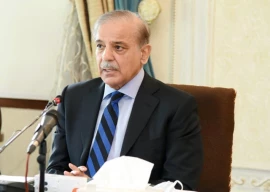
Finally, the Pakistan Democratic Movement government on Friday threw open public coffers ahead of the next general elections and decided to increase the next fiscal year’s federal development budget by 31% to Rs950 billion.
The decision to increase the Public Sector Development Programme (PSDP) from the earlier proposed Rs700 billion to Rs950 billion was taken by Prime Minister Shehbaz Sharif minutes before the scheduled meeting of the Annual Plan Coordination Committee (APCC).
The confusion was apparent. The Ministry of Planning had distributed the APCC working paper among all stakeholders based on the Rs700 billion PSDP size. But Planning Minister Ahsan Iqbal told the media that the size of the PSDP will be Rs950 billion, excluding Rs150 billion to be spent by the private sector.
Subsequently, the APCC recommended a Rs2.5 trillion cumulative national development outlay for spending by the federal government and the four provinces. The Rs2.5 trillion allocation was Rs90 billion or 4% higher than this fiscal year.
The APCC also approved a 3.5% GDP growth target with sectoral growth of 3.5% in agriculture, 3.4% in industries and 3.6% in services for the fiscal year 2023-24. The inflation target for the next fiscal year is set at 21%.
The APCC approved Rs950 billion for the federal development budget – up by Rs223 billion or 31% for over this year’s original allocation. The finance ministry had approved Rs700 billion ceiling, which the planning ministry was strongly contesting.
Iqbal said that the PSDP provides an opportunity to leverage scarce public resources for priority sectors. He said that the development projects relating to 5Es, i.e., exports, equity, empowerment, environment and energy framework; CPEC as well as 4RF, i.e., resilient, recovery, rehabilitation and reconstruction framework in the aftermath of catastrophic flood 2022 have been assigned priority while allocating resources under the PSDP 2023-24.
Various ministries had demanded over Rs2.6 trillion for 2,035 projects having a throw-forward of Rs8 trillion under the PSDP 2023-24. The IMF estimated the throw-forward-month needed to complete the approved projects at Rs12 trillion.
The APCC also endorsed Rs1.56 trillion development outlays for the four provinces. The interim governments of Punjab and Khyber-Pakhtunkhwa have proposed smaller development allocations till October 2023.
The proposed budgets will now be presented to the National Economic Council next week for its endorsement. The NEC is the constitutional economic decision-making body, which is headed by the Prime Minister Shehbaz Sharif.
The four provinces will spend Rs1.559 trillion from their own resources. Punjab has proposed a Rs426 billion development budget for just four months, which is significantly lower than this year’s Rs712 billion revised estimates.
Sindh has allocated Rs617 billion budget compared to Rs442 billions of this fiscal year, showing a huge increase of 40% ahead of elections.
Khyber-Pakhtunkhwa allocated Rs268 billion for the development spending for four months compared to this year’s revised figure of Rs373 billion. The Balochistan government also proposed Rs248 billion development budget for the next fiscal year, showing an increase of 65% over this fiscal year’s revised estimates.
The parliamentarians’ schemes have been given Rs90 billion compared to Rs111 billion of this fiscal year. The federal development portfolio is marred by various issues due to lack of resources, poor planning, management and execution.
The coalition government made many adjustments within this year’s development budget due to changes in its priorities. An amount of Rs64 billion was re-appropriated by the ministries from one project to another while supplementary grants of Rs75 billion were also secured.
An amount of Rs12 billion was diverted from this year’s PSDP towards conduct of the 7th Population and Housing Census. Likewise, an amount of Rs8 billion was adjusted to the current side by the Ministry of Maritime Affairs for provision of 2000 engines to poor fishermen, Gwadar.
The planning ministry said that about 164 projects costing Rs294 billion would be completed by the end of this fiscal year.
The share of the provincial nature projects further increased to 31% of the total federal PSDP, which further thinned out already limited resources.
The issue of arrears of the defunct Earthquake Reconstruction and Rehabilitation Authority remained unresolved. The APCC was informed that the federal government provided yearly allocations to the tune of Rs180 billion up to FY-2022-23. The ERRA could not fully discharge its assigned tasks within the stipulated period and liabilities were building up during the period. The government had decided to merge ERRA into the National Disaster Management Authority in the year 2018 but it has never been implemented.
The APCC also approved guidelines to address these issues. It recommended that only those provincial schemes should be funded where the provincial government shares half of the cost.
It also proposed that the total PSDP should be handed over to the Planning Ministry in four equal quarterly tranches instead of giving only 10% during the first quarter. The APCC has recommended providing the foreign exchange cover wherever required and also exempt the development spending from austerity measures like ban on procurement.
It has also proposed that the Ministry of Finance should not deduct interest on cash development loans given to the Pakistan Atomic Energy Commission, Power Division and the National Highway Authority.
The APCC sought banning of diverting development funds for the current expenditures.




















COMMENTS (2)
Comments are moderated and generally will be posted if they are on-topic and not abusive.
For more information, please see our Comments FAQ